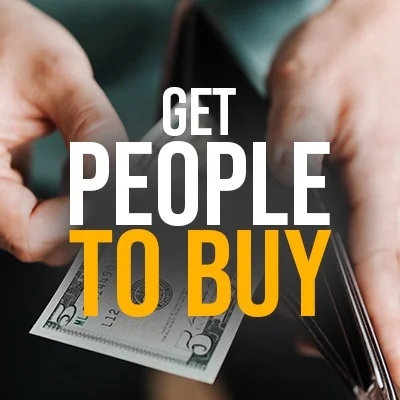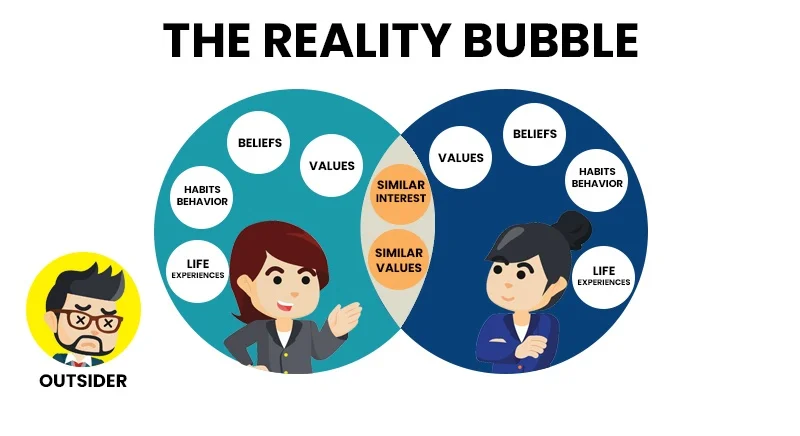If you want to know why your customers are hesitant to click the “BUY” button, read this.
There could be many reasons that your customers are not buying from you.
But, let us understand the main reasons that will brush your customers off your sales page.
To get customers to buy your product starts with the understanding of the art of persuasion.

Today, I am going to turn the “Art” of Persuasion into “Science”…
So that you can apply this formula to any of your content or sales pages and turn it into gold.
Persuasion, in business terms, is simply to understand your customers intimately in order to build rapport and trust.
In return, it allows you to shift your customers’ attitude and behavior and get them to buy your product or services.
The first step to understanding persuasion and to increase sales conversion rate, is to enter your Customers’ Reality Bubble…
Step 1: Understanding the Reality Bubble of Your Customers
Wait! What the heck is a Reality Bubble?
A Reality Bubble is a set of assumptions about the quality of experiences of an individual.
It is a person’s perception of the way they act or behave, which is governed by their beliefs and values acquired through their day to day experiences.
Let me explain…
Imagine yourself as a person living in a bubble (Your Reality Bubble).
And, within that bubble there are many little bubbles which each represents your life experiences, believes, thoughts, feelings, habits, values, etc., and they are all unique to non other than you.
But, someone else could share a subset of your little bubble if there are similarities.
For example, if both you and I love to exercise, we share an intertwined Reality Bubble with each other. That gives us a connection.

Many friendships and relationships are forged between individuals who share many intertwined Reality Bubbles.
Our Job as Internet Marketers
So, as Internet marketers, our job is to step into our customers’ Reality Bubble and shift them closer to ours.
Our primary goal is to influence and get customers to buy our products without being salesy.
Most importantly, we do not want to be perceived as an outsider.
Caution: Stepping into your customers’ Reality Bubble is like stepping into a minefield.
I’ll explain more below on those mines and how you can avoid them.
In order to step into your customers’ Reality Bubble…
You have to identify the intertwined Reality Bubbles between you and your group of Target Customers.
Your Actionable Step: Define your target customers and research on them. Write down a list of common values, beliefs, interest, habits, etc, that your target customers share.
One thing you must understand, is that there is no point in trying to convince people who are not your target customers.
Not everyone is a good match for your products.
And, you obviously do not want to handle a high volume of refund and complaints.
You want to get customers to buy your product only if they are interested in it, in need of it, or they want it.
So, defining your target customers is a crucial step.
Step 2: Stepping in Your Customers’ Reality Bubble
It is like unlocking a safe, similar to the ones you see on the movies, where the locksmith figures the several “Clicks” before the safe is unlocked.
Every customer who have been through your sales funnel has an imaginary safe protecting their Reality Bubble.
And, if you have done the actionable step above, you would’ve unlocked the safe.
But, you will land yourself into a minefield that will blow up your sale at any time.
So, before you start stepping onto any mines, which I am going to discuss more on Step 3…
Let us take a step back to lay a firm bridge across the minefield by building trust with your customers.
Remember, your ultimate goal is to lead your customers to join your Reality Bubble.
At any time your customers feel that they’re being forcing to join your Reality Bubble, the mine will be set off.
So, let’s lay the bridge by building Trust and Rapport, but how do you do that?
How to Build Trust and Rapport with Your Customers?
The strategies shared in the video above on how to build rapport does not only apply to face-to-face meeting, it applies to everything we do online.
The take away from the video is “People like people who are like themselves”.
Your Actionable Step: Whenever you’ve completed an article or a sales page, put yourself in your customers shoe (bearing in mind all the problems and frustration faced by your customers).
Then, ask yourself “Do you feel connected with the content?”
If not, craft your content again and repeat this step until you feel connected to it.
Of course, if you can request your existing customers to provide feedback for you, it would be most valuable.
Step 3: Friction is the Root of all Rejection, Avoid it at all cost!
The problem with getting people to buy your product online is that you can’t figure out your customers’ facial expression when they are going through your sales funnel.
You wouldn’t even know if you’ve offended your customers.
And, you can’t mitigate or recover from a mistake that you’ve made.
Its like stepping on a mine in a minefield.
Believe it or not, there is a minefield in every of your customers mind which consist of their beliefs and values.
And, every word that is uttered in your sales funnel may potentially set off the mine and blow up the sale.
Friction is inevitable when you are trying to penetrate your customers’ Reality Bubble, and get them to buy your product.
So, how can your reduce or avoid that friction.
How to Avoid Rejection?
The first step is to identify the potential friction mines and face them head on, even before that friction comes to your customers’ mind.
For example, as your customer goes through your sales pitch, a thought might surface in your customer’s mind, like “can this product really solve the problems that I have?”.
So, even before that thought comes to your customer’s mind, you can tackle it by describing in detail the problems that your customer have, and how your product can solve the problems.
When you talk about a potential friction even before your customers can think of it…
It demonstrates to your customers that you understand them intimately, and that you are looking at their problems in their perspective.
If the price of your product is higher than your competitors, which may be potential friction, you can instill thoughts to your customers’ mind at an early stage that the price of your product is not the determining factor of the sale, it is the higher value that it can provide.
Your Actionable Step: Go through your sales funnel and jot down any thoughts that comes to your mind.
If you can, invite a few of your loyal customers to go through your sales funnel again.
Then, request that they share their insights with you.
Re-do your sales funnel to tackle the potential friction.
Step 4: Be the “Like-able” Hero by Telling Your Story
Before you even present your product or service to your customers…
And, after you have demonstrated that you understand your customers from their perspective…
It is time present yourself as a Likable Hero.
Like Superman or Spider-man in many ways, less the superpowers, you can be the person who your customers embrace.
You want to be the person whom your customers can relate to, and the person whom they want to follow and learn from.
This can be achieved by telling Your Story.
Stories sell, but not all do.
There is a Story Selling formula which is widely used in almost every successful movies, businesses and advertisements.
And, you can definitely use this formula to subtly get customers to buy your product or to better your sales pitch.
Story connects, and when done properly, your customers will embrace you and your products.
The table has turned, your customers will flock to you instead of you reaching out to them.
The story above connects with almost everyone, it reminds people to be kind to one another.
The Thai Life Insurance didn’t produce this advertisement to sell more insurance policies, instead they use it to brand their business.
So, it really depends on the purpose of your story. Make sure you craft a story that serves your purpose.
Your Actionable Step: Read the Story Selling Formula, define the purpose of your story, and craft your story.
Step 5: Shifting Your Customer’s Mindset
Now that we understand:
- Understand our customers thoroughly;
- Identified the emotions caused by their problems or issues; and
- You have presented yourself as the Likeable Hero
The next step is to help your customers understand and accept their problems and frustrations.
The simplest way to do this is by telling them it is not their fault for feeling or behaving that way.
It is like standing by a friend when she or he needed help the most.
I am sure you encounter this situation when your friend reaches out to you to solve a problem.
70% of the time, your friend will heed your advice even when they didn’t fully agree with you.
As long as you present your solution that makes sense to them, they will do what you tell them to do.
The cornerstone of shifting your customers’ mindset, and getting them to buy your product, is the trust and rapport you’ve built with them.
If you have done the actionable steps above…
You would have avoided a potential friction, and you can use the rapport to steer them towards the direction to your favor.
Is It Manipulation?
Wait a minute, isn’t this manipulation?
I admit, this is a manipulation technique.
But, if you use the technique to the highest ethical degree, your customers will not feel manipulated.
Instead, they will thank you for introducing them the product or service that you are offering.
For example, imagine that you are trying to sell a weight loss program to people who are obese.
What may be the potential friction mines? Here are several that I can think of:
- Any words or ideas that resonates being Fat or lazy
- Don’t like to be teased about their weight
- Feel embarrassed when any parts of their body are showing
When you craft a sales message to these people, instead of trying to avoid using words like fat or lazy, use these words to connect with them.
How to Connect With Your Customers?
For example:
“Several years ago, my friends often make jokes like, “Don’t worry about finding a spare tire when your car breaks down, Jack has one wrapped around his stomach” or “You can hardly miss Jack, he’s such a big object”, and I often get so frustrated and embarrassed about these jokes.
The fact is I’ve been trying to lose weight for the longest time.
And, every time I get teased, I feel so depressed and often I gave up fighting back. I just accepted that I am fat and lazy, and fell back to my old eating habits.
But, deep down in my heart, I know I want to look good…..
It is not your fault for being fat, you just didn’t know the right techniques…..
Now, I will show you the way…”
The magical thing about having a connection with your customers is that all the mines are gone. They are more receptive to buy your product.
And, you are free to maneuver their thoughts to bring them into your Reality Bubble.
Your Actionable Step: Brainstorm what you want your customers to think, feel and do, once they’ve entered your Reality Bubble.
Step 6: Time to Close the Deal
Many marketers and business owners shy away at the point of asking for a sale because they became uncomfortable talking about the price.
So far, you’ve:
- Entered your customers’ Reality Bubble;
- Tackled all the possible objections;
- Implanted the Likeable Hero in their minds; and
- Shifted their Reality Bubbles to yours.
Believe it or not, your customers already expect a sale from you.
But, if you don’t get people to buy your product or ask for the sale, they won’t do it.
There are several highly effective methods that you can use to get customers to buy your product without being salesy.
I’ll share an example for each of the methods here, so you’ll understand how it works.
Method #1: The Subtle Method
“My product has helped thousands of people get out of debt, and I know that it can help you too.
It is fine if you don’t take on my offer now.
But, that would mean that you’ll continue to pile up your debt.
And, it’ll get worst every single day.
I really want to help you, but I’ll leave the decision with you.”
Method #2: It’s Now or Never
“For today only, I’ll slash the price of the product by 20%.
Thereafter, it will be full price, and there is a high possibility that the price will continue to increase.
I really want you to benefit from this offer, so do not miss it.”
Method #3: Value Proposition
“On top of the main product that you are getting, I will give you this bonus which cost $599.
Plus, I will hand hold you to….
By now, I am sure you know you are getting more than what you are paying for”
Method #4: No Risk
“I am very certain that you will solve your problem by using my product.
But, if you feel that my product isn’t doing what it is supposed to do…
You can email me, and I will give you a full refund, no questions asked.”
Method #5: Pros and Cons
“Here is a list of pros and cons when you buy my product. The Pros clearly outweigh the Cons. I’ll let you decide.”
Method #6: Feel, Felt, Found
“I totally understand where you are coming from (Feel).
Thousands of my existing customers felt the same way (Felt).
Many of them left this offer and came back after a few months, because they found that my offer trumps others (Found).”
Of course, you mix and match the methods to suit your offer. There is no hard and fast rule on this.
Are You Ready to Persuade Your Customers?
There you have it, the formula for persuasion, and to get customers to buy your product.
- Step 1: Understanding the Reality Bubble of your Customers
- Step 2: Stepping into Your Customers’ Reality Bubble
- Step 3: Avoid Friction at all Cause
- Step 4: Be the Likeable Hero by Telling Your Story
- Step 5: Shifting Your Customers’ Mindset
- Step 6: Close the Deal
Now that you are equipped with the formula for persuasion, it is time to put the knowledge to work.
Use the formula for persuasion in conjunction with the Sales Page Formula, and you will have a highly convertible sales page or funnel.
Thank you for taking the time to read this article.
If you find this article helpful, please help to share it.
Talk to you soon!
